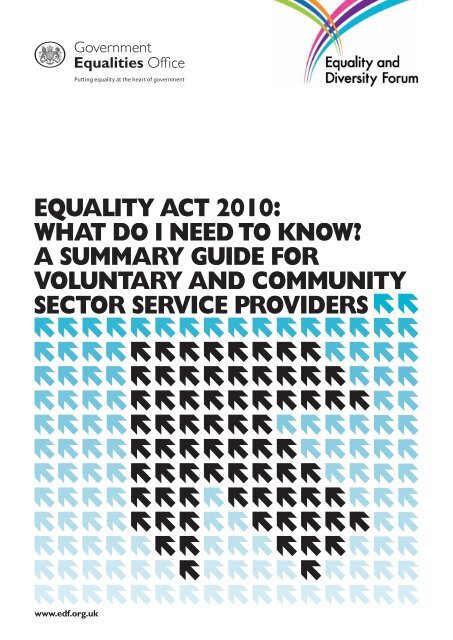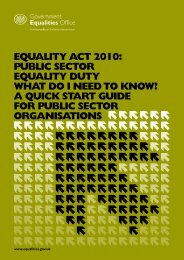Equality Act 2010: What do I need to know? - Gov.uk
Equality Act 2010: What do I need to know? - Gov.uk
Equality Act 2010: What do I need to know? - Gov.uk
- No tags were found...
You also want an ePaper? Increase the reach of your titles
YUMPU automatically turns print PDFs into web optimized ePapers that Google loves.
EQUALITY ACT <strong>2010</strong>:WHAT DO I NEED TO KNOW?A SUMMARY GUIDE FOR VOLUNTARY AND COMMUNITY SECTOR SERVICE PROVIDERSwww.edf.org.<strong>uk</strong>
ForewordThe <strong>Equality</strong> <strong>Act</strong> <strong>2010</strong> replaces the existing antidiscriminationlaws with a single <strong>Act</strong>. It simplifies thelaw, removing inconsistencies and making it easierfor people <strong>to</strong> understand and comply with it. It alsostrengthens the law in important ways <strong>to</strong> help tacklediscrimination and inequality.This summary guide tells you how the <strong>Equality</strong><strong>Act</strong> <strong>2010</strong> changes how you have <strong>to</strong> act in order<strong>to</strong> prevent and address discrimination when youprovide goods, facilities and services <strong>to</strong> the public,for example as a residential care home, communityshop or after-school club. These parts of the <strong>Act</strong> willcome in<strong>to</strong> effect on 1 Oc<strong>to</strong>ber <strong>2010</strong>.2
IntroductionThe <strong>Equality</strong> <strong>Act</strong> <strong>2010</strong> brings <strong>to</strong>gether, harmonisesand in some respects extends the current equalitylaw. It aims <strong>to</strong> make it more consistent, clearerand easier <strong>to</strong> follow in order <strong>to</strong> make societyfairer. As a provider of goods, facilities or servicesin the voluntary and community sec<strong>to</strong>r yourresponsibilities remain largely the same, but thereare some differences that you <strong>need</strong> <strong>to</strong> be awareof. These changes are summarised in the table onthe next page.There are other guides for employers, business andindividuals. The guide for employers will help thevoluntary and community sec<strong>to</strong>r with employmentissues.This series of guides covers key changes that arecoming in<strong>to</strong> effect on 1 Oc<strong>to</strong>ber <strong>2010</strong>. The <strong>Equality</strong><strong>Act</strong> also contains other provisions, including thenew concept of dual discrimination, an extendedpublic sec<strong>to</strong>r <strong>Equality</strong> Duty and a prohibition on agediscrimination in services and public functions. The<strong>Gov</strong>ernment is looking at how the rest of the <strong>Act</strong>can be implemented in the best way for business,and will make an announcement in due course.The <strong>Act</strong> protects the same groups of people thatwere covered by previous equality legislation,by reference <strong>to</strong> what are now called ‘protectedcharacteristics’. The characteristics covered by thisguide are disability, gender reassignment, pregnancyand maternity, race, religion or belief, sex and sexualorientation.3
<strong>What</strong>’s new for the voluntary and community sec<strong>to</strong>r – an overviewKeyCharacteristic covered in existing legislation – no changesCharacteristic covered in existing legislation – but some changesCharacteristic not covered in existing legislation – now coveredCharacteristic not covered in existing legislation – still not coveredNo changeChangesNewNo protectionDisabilityGenderreassignmentPregnancy andmaternityRaceReligion orbeliefSexSexualorientationDirect discrimination Changes No change No change No change No change No change No changeDiscrimination byassociationDiscrimination byperceptionNew New No protection No change No change New No changeNew New No protection No change No change New No changeIndirect discrimination New New No change No change No change No change No changeHarassment Changes Changes Noprotection*ChangesNoprotection*ChangesNoprotection*Victimisation Changes Changes Changes Changes Changes Changes ChangesPositive action Changes Changes Changes Changes Changes Changes ChangesAssociations andprivate members’ clubsNo change New New No change New New No changeCharities Changes Changes Changes Changes Changes Changes ChangesDiscrimination arisingfrom disabilityReasonableadjustmentsNewChanges* Where there is no specific harassment protection, direct discrimination protection prohibits treatment such as bullyingand harassment which results in a person being treated less favourably.4
Who has responsibilities?The <strong>Act</strong> applies <strong>to</strong> all organisations that providea service <strong>to</strong> the public, or a section of the public(service providers). It also applies <strong>to</strong> anyone whosells goods or provides facilities. For example, it willcover community centres, information and adviceagencies, charity shops, sports clubs, internet-basedservices, and residential care homes and day carecentres. It applies <strong>to</strong> all your services, whether ornot a charge is made for them. It also applies <strong>to</strong>private clubs and other associations with 25 ormore members.Who is protected?The <strong>Act</strong> protects people who have a ‘protectedcharacteristic’ (these used <strong>to</strong> be called ‘grounds’).The relevant characteristics are:• disability (definition changed)• gender reassignment (definition changed)• pregnancy and maternity• race – this includes ethnic or national origins,colour and nationality• religion or belief• sex, and• sexual orientation.Disability (changed)The protected characteristic of disability applies <strong>to</strong>a person who has a physical or mental impairmentthat has a substantial and long-term adverse effec<strong>to</strong>n their ability <strong>to</strong> carry out normal day-<strong>to</strong>-dayactivities.<strong>What</strong> has changed?To qualify for protection from discrimination, adisabled person no longer has <strong>to</strong> show that theirimpairment affects a particular capacity, such asmobility or speech, hearing or eyesight.For further details see the Disability Quick StartGuide.Gender reassignment (changed)The protected characteristic of gender reassignmentwill apply <strong>to</strong> a person who is proposing <strong>to</strong> undergo,is undergoing or has undergone a process <strong>to</strong> changetheir sex.<strong>What</strong> has changed?To qualify for protection from discrimination atranssexual person no longer has <strong>to</strong> show that theyare under medical supervision.For further details see the Gender ReassignmentQuick Start Guide.5
<strong>What</strong> the law prohibitsHere are some examples of the different kinds ofconduct that are prohibited under the <strong>Act</strong>.Direct discrimination (changed)Direct discrimination occurs when a person istreated less favourably than another person becauseof a protected characteristic.ExampleBeatrice visits her local credit union.She asks for a small loan <strong>to</strong> enable her<strong>to</strong> buy a fridge. They refuse <strong>to</strong> lendher any money because they say that awoman is less likely <strong>to</strong> have a job and beable <strong>to</strong> repay the loan. This is direct sexdiscrimination.<strong>What</strong> has changed?Protection from direct discrimination in services isnew for disability.Association and perceptionDirect discrimination can also take place becauseof a protected characteristic a person <strong>do</strong>es notpersonally have. For example, it includes a personbeing treated less favourably because they are linke<strong>do</strong>r associated with a person who has a protectedcharacteristic.ExampleJane is not allowed in<strong>to</strong> her localcommunity centre with her son becausehe is disabled. This is discriminationagainst her by association.Direct discrimination also includes discriminationbecause a person is wrongly thought <strong>to</strong> have aparticular protected characteristic or is treated as ifthey <strong>do</strong>.ExampleSamantha, who is straight, goes on aGay Pride march <strong>to</strong> support some ofher lesbian, gay, bisexual and transgendercolleagues, and while there collects a‘Support Gay Pride’ badge.After themarch she goes in<strong>to</strong> the communitycentre bar for a drink.The barmanrefuses <strong>to</strong> serve her as he believes thatshe is a lesbian because of the badgeshe is wearing and because he saw heron the march. This is discrimination byperception.<strong>What</strong> has changed?Previously protection extending wider than theperson’s own protected characteristic – suchas protection from discrimination because ofassociation and perception – applied only <strong>to</strong> race,religion or belief, and sexual orientation. Now itapplies <strong>to</strong> sex, disability and gender reassignmentas well.6
Indirect discrimination (changed)Indirect discrimination happens when there is a rule,a policy or even a practice that applies <strong>to</strong> everyonebut which particularly disadvantages people whoshare a particular protected characteristic. Indirectdiscrimination can be justified if it can be shownthat the rule, policy or practice is intended <strong>to</strong>meet a legitimate objective in a fair, balanced andreasonable way. If this can be shown it will belawful. When considering introducing a new ruleor policy, you should first consider whether thereis any other way <strong>to</strong> meet your objectives thatwould not have a discrimina<strong>to</strong>ry effect or thatis less likely <strong>to</strong> disadvantage people who have aprotected characteristic. Remember that a lack offinancial resources alone is unlikely <strong>to</strong> be a sufficientjustification.ExampleJamal is a devout Muslim refugee whowishes <strong>to</strong> get advice on his immigrationstatus. He finds that the local advicecentre only offers immigration adviceon Fridays at 12.00. This is a rulethat disadvantages him as he cannotattend then because he has <strong>to</strong> go<strong>to</strong> the mosque. This will be indirectdiscrimination if the advice centrecannot show a good reason for onlyholding advice sessions on immigrationat that time on a Friday. They may beable <strong>to</strong> offer him an appointment atanother time, in which case there will beno indirect discrimination.<strong>What</strong> has changed?Indirect discrimination now applies <strong>to</strong> disability andgender reassignment as well as the other protectedcharacteristics.Discrimination arising from disability (new)Discrimination arising from disability occurs when adisabled person is treated unfavourably because ofsomething connected with their disability and thisunfavourable treatment cannot be justified.Treatmentcan be justified if it can be shown that it is intended<strong>to</strong> meet a legitimate objective in a fair, balancedand reasonable way. If this can be shown then thetreatment will be lawful.This form of discrimination can occur only if theservice provider <strong>know</strong>s or can reasonably beexpected <strong>to</strong> <strong>know</strong> that the disabled person isdisabled.ExampleJanet is blind and requires the assistanceof a guide <strong>do</strong>g.She is not allowed in<strong>to</strong>a cafe because the owner believes thatthe <strong>do</strong>g would be a safety risk.She isexcluded not because she is blind,butbecause of her use of a guide <strong>do</strong>g,which issomething connected with‘arising from’)her disability.Unless the cafe owner canobjectively justify his treatment of Janet,she will have experienced discriminationarising from disability.<strong>What</strong> has changed?This is a new form of protection. It replaces differentprotection in disability discrimination law that wasnot fully effective.7
Harassment – disability, genderreassignment, race or sex (changed)Harassment means unwanted behaviour related<strong>to</strong> a protected characteristic that has the purposeor effect of violating a person’s dignity or creatingan intimidating, hostile, degrading, humiliating oroffensive environment for them.ExampleAhmed, a refugee from Afghanistan anda keen footballer, joins his local footballclub. Whenever he goes <strong>to</strong> a practicesession the coach asks him why he<strong>do</strong>es not go home <strong>to</strong> where he camefrom. Ahmed could bring a claim ofharassment related <strong>to</strong> his race.<strong>What</strong> has changed?Harassment protection has now been extended <strong>to</strong>disability and a single definition of harassment nowapplies <strong>to</strong> disability, gender reassignment, race andsex.For further details see the Harassment Quick StartGuide.Harassment – religion or belief or sexualorientation (no change)There is no specific prohibition on harassmentrelated <strong>to</strong> religion or belief or <strong>to</strong> sexual orientation.However, if you harass someone because of theirreligion or belief or their sexual orientation, andconsequently treat them less favourably than youwould treat someone else, a court would count thisas direct discrimination, which is unlawful.ExampleElsie and Frances, a lesbian couple, visittheir local lunch club regularly. Recentlya new helper has been taken on. Thisnew helper keeps asking them abouttheir sex life and refuses <strong>to</strong> serve themuntil after everyone else. She <strong>do</strong>esnot ask any of the other users abouttheir sex lives. This unwanted conductis occurring because of Elsie’s andFrances’s sexual orientation and putsthem at a disadvantage. It is likely <strong>to</strong>amount <strong>to</strong> direct discrimination.For further details see the Harassment Quick StartGuide.8
Victimisation (changed)Victimisation occurs when a service providertreats someone badly because they have madeor supported a complaint about discrimination orharassment, or because the service provider thinksthat they are <strong>do</strong>ing or may <strong>do</strong> these things. It willalso be victimisation if a service provider treatssomeone badly because they support someone elsewho makes a discrimination claim. A person is notprotected from victimisation if they have maliciouslymade or supported an untrue complaint.ExampleComfort, who has schizophrenia, andher friend Christine regularly go <strong>to</strong> abingo session at their local communitycentre. One day one of the assistants atthe centre makes an offensive remark<strong>to</strong> Comfort about her schizophrenia.Comfort complains <strong>to</strong> the managerof the centre and Christine supportsComfort’s complaint.The managerpromises <strong>to</strong> investigate but the nexttime Comfort and Christine go <strong>to</strong> thecentre they are <strong>to</strong>ld that they are nolonger welcome there. This is unlawfulvictimisation of both women.<strong>What</strong> has changed?There is now no <strong>need</strong> for a victim <strong>to</strong> show thatthey have been less favourably treated thansomeone who has not made or supported acomplaint under the <strong>Act</strong>. They <strong>need</strong> only show thatthey have been treated badly.Other changes you <strong>need</strong> <strong>to</strong><strong>know</strong> aboutPositive action (changed)Some people with protected characteristics aredisadvantaged or under-represented in someareas of life, or have particular <strong>need</strong>s linked <strong>to</strong>their characteristic. They may <strong>need</strong> extra helpor encouragement if they are <strong>to</strong> have the samechances as everyone else. The new positiveaction provisions enable service providers <strong>to</strong> takeproportionate steps <strong>to</strong> help people overcome theirdisadvantages or <strong>to</strong> meet their <strong>need</strong>s.Note that:• there is no requirement <strong>to</strong> take positive action,and• there is no restriction on treating disabled peoplemore favourably than non-disabled people. It isalso permitted <strong>to</strong> take steps <strong>to</strong> meet the <strong>need</strong>sof people with a particular disability.ExampleThe organisers of a north Lon<strong>do</strong>n youthclub in an area with a substantial Muslimpopulation notice that they have veryfew Muslim members. They thereforedecide <strong>to</strong> advertise their sessions at thelocal mosque and ensure that they servesome halal food in order <strong>to</strong> attractmore Muslim members and meet theirdietary <strong>need</strong>s.This is permitted positiveaction.9
<strong>What</strong> has changed?The previous provisions were complicated anddifficult <strong>to</strong> apply. These new provisions are simplerand clearer <strong>to</strong> use.BreastfeedingThe <strong>Act</strong> has specifically clarified that it is unlawful<strong>to</strong> discriminate against a woman because she isbreastfeeding.For further details see the Business – BreastfeedingQuick Start Guide.Associations and clubs (changed)Special rules apply <strong>to</strong> clubs and other associationswith 25 or more members whose membership iscontrolled by rules and involves a selection process.They can restrict their membership <strong>to</strong> people witha protected characteristic, provided that this is nota group defined by colour. However, they cannotdiscriminate against members or people applying <strong>to</strong>become members or members’ guests on any otherprotected ground.ExampleAn association could restrict itsmembership <strong>to</strong> Afro-Caribbean boys or<strong>to</strong> people of African origin. It would notbe permitted <strong>to</strong> restrict its membership<strong>to</strong> black boys or <strong>to</strong> black people.<strong>What</strong> has changed?These special rules have now been extendedbeyond race, disability and sexual orientation <strong>to</strong>cover sex, religion or belief, gender reassignment,and pregnancy and maternity.10For further details see the Clubs and otherAssociations Quick Start Guide.Charities (changed)Special rules allow charities <strong>to</strong> provide benefits onlyfor people with a particular protected characteristic(but not a group defined by colour), providedthat the charity acts on the basis of its charitableinstrument (the <strong>do</strong>cument that set it up), and this:• can be justified as intended <strong>to</strong> meet a legitimateobjective in a fair, balanced and reasonable way,or• is for the purpose of preventing or compensatingfor a disadvantage linked <strong>to</strong> that protectedcharacteristic.ExampleA charity, whose constitution states thatits objective is <strong>to</strong> provide facilities andcare for transsexuals, plans <strong>to</strong> providesupport for a transsexual <strong>to</strong> help heradapt <strong>to</strong> and cope with the changesshe and her family experience. This isa legitimate aim and the provision ofspecialist support only for transsexualpeople is a proportionate way <strong>to</strong>achieve this aim.<strong>What</strong> has changed?Charities benefiting only people of the same racialgroup, religion or belief, or sexual orientation mustnow show that this is intended <strong>to</strong> meet a legitimateobjective in a fair, balanced and reasonable way orthat it is positive action as well as being in line withtheir charitable instrument. There is also now anexception along these lines for charities benefitingonly people with the same disability.
<strong>What</strong> <strong>do</strong> you <strong>need</strong> <strong>to</strong> <strong>do</strong> now?Further sources of informationVoluntary and community organisations that alreadyhave good equality procedures in place will not<strong>need</strong> <strong>to</strong> take much further action. However, it willbe wise <strong>to</strong>:• inform your staff and management committee ofthe new provisions,• review your equality policies and make sure thatthey cover all relevant protected characteristics,and• consider whether your staff <strong>need</strong> any furthertraining.You may also wish <strong>to</strong> consider whether there areany groups that are not as well represented amongyour service users as they should be, and if soconsider whether you could use positive action <strong>to</strong>encourage them <strong>to</strong> use your organisation more.The <strong>Equality</strong> and Human Rights Commission isthe statu<strong>to</strong>ry body established <strong>to</strong> help eliminatediscrimination and reduce inequality. It will issuea Statu<strong>to</strong>ry Code of Practice explaining in moredetail the law in relation <strong>to</strong> service provision anddiscrimination. It also produces a range of materialproviding practical guidance on how <strong>to</strong> complywith the law.www.equalityhumanrights.com0845 604 6610Law Centres Federationwww.lawcentres.org.<strong>uk</strong>Citizens Advicewww.citizensadvice.org.<strong>uk</strong>Advice UKwww.advice<strong>uk</strong>.org.<strong>uk</strong><strong>Gov</strong>ernment Equalities Officewww.equalities.gov.<strong>uk</strong>National Council forVoluntary Organisationswww.ncvo-vol.org.<strong>uk</strong>Charity Commission for England and Waleswww.charity-commission.gov.<strong>uk</strong>Office of the Scottish Charity Regula<strong>to</strong>rwww.oscr.org.<strong>uk</strong>Scottish Council forVoluntary Organisationswww.scvo.org.<strong>uk</strong>Wales Council forVoluntary <strong>Act</strong>ionwww.wcva.org.<strong>uk</strong>11
© Crown copyright <strong>2010</strong>JN401727July <strong>2010</strong>







